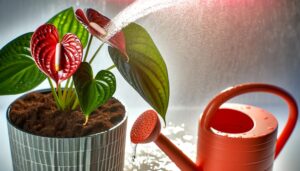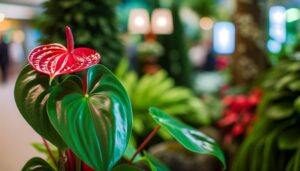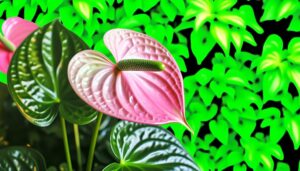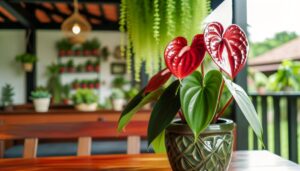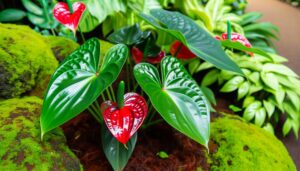How Often Should You Water Your Red Anthurium?
Red Anthuriums should be watered when the top inch of soil feels dry, generally every 1-2 weeks. Best care involves a well-draining potting mix composed of peat, perlite, and pine bark.
Excessive moisture leads to yellowing leaves and root rot, while inadequate watering causes wilting and drooping. During spring and summer, frequency can be increased to every 5-7 days, but should be reduced to every 10-14 days in fall and winter.
Always use room-temperature, dechlorinated water. Adequate soil moisture and humidity levels (around 60-80%) are essential for healthy growth, discover more about ideal Anthurium care by continuing further.
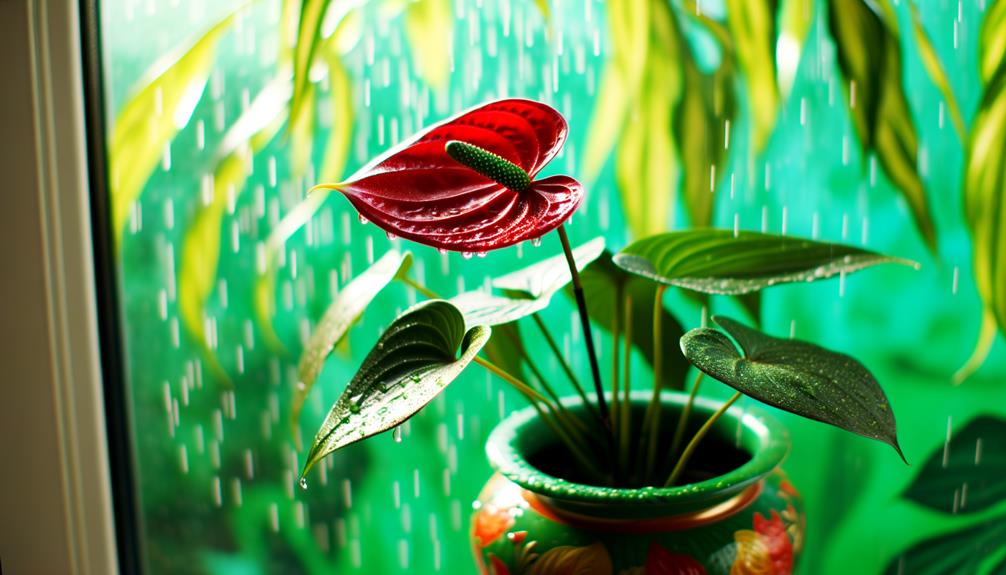
Key Takeaways
- Water red anthuriums when the top inch of soil feels dry to the touch.
- Typically, water every 1-2 weeks, adjusting for environmental conditions.
- Increase watering frequency to every 5-7 days during spring and summer.
- Decrease watering to every 10-14 days in fall and winter.
- Ensure the soil remains moist but not waterlogged to prevent root rot.
Understanding Red Anthurium's Water Needs
Red Anthuriums require consistent but moderate watering to maintain ideal soil moisture levels for healthy growth. These tropical plants thrive in substrates that are uniformly moist but not saturated, necessitating a precise balance.
Employing a well-draining potting mix, such as one containing peat, perlite, and pine bark, facilitates best moisture retention while preventing waterlogging. Empirical evidence suggests that watering once the top inch of soil feels dry to the touch can help achieve this equilibrium.
Additionally, using room-temperature, dechlorinated water minimizes potential stressors on the plant. Monitoring environmental factors, such as ambient humidity and temperature, is essential; higher humidity or warmer conditions may necessitate more frequent watering, whereas cooler, less humid environments may require reduced watering intervals.
Indicators of Overwatering
Indicators of overwatering in Red Anthurium include yellowing leaves and signs of root rot.
Yellowing leaves, often accompanied by wilting or browning, suggest impaired chlorophyll synthesis due to excessive soil moisture.
Root rot, characterized by a foul odor and mushy roots, results from prolonged waterlogged conditions that promote pathogenic fungal growth.
Yellowing Leaves
Frequently, yellowing leaves in Anthurium plants serve as a primary indicator of overwatering, which can lead to root rot and other serious health issues. Excess moisture in the soil disrupts oxygen availability to roots, causing chlorosis where leaves turn yellow. To diagnose overwatering, observe the plant's overall health and soil moisture levels.
| Symptom | Cause | Action Required |
|---|---|---|
| Yellowing Leaves | Overwatering | Reduce watering frequency |
| Wilting | Root rot | Improve drainage |
| Leaf Drop | Waterlogged soil | Repot in well-draining mix |
| Soil Odor | Fungal growth | Check for root damage |
| Slow Growth | Poor aeration | Aerate soil |
Implementing these actions can mitigate overwatering consequences and restore plant well-being.
Root Rot Signs
One significant consequence of overwatering in Anthurium plants is root rot, characterized by dark, mushy roots and a foul odor emanating from the soil. Recognizing the signs early can prevent irreversible damage.
The following indicators are essential to identify:
- Wilting Leaves: Despite adequate watering, leaves may appear limp or droopy due to impaired root function.
- Discoloration: Leaves may exhibit yellowing or browning, often starting from the tips and edges.
- Poor Growth: Stunted growth or sudden cessation in new leaf production may indicate compromised root health.
To mitigate root rot, ensure proper drainage, use a well-aerated potting mix, and allow the soil to dry between waterings.
Monitoring these indicators closely will help maintain the health of your Red Anthurium.
Signs of Underwatering
Underwatering your Red Anthurium can be identified by several key indicators, including wilting and drooping leaves, which signal a lack of turgor pressure.
Additionally, the soil surface will appear dry and may pull away from the edges of the pot, signifying insufficient moisture levels.
Ensuring regular and adequate irrigation is essential for maintaining the plant's physiological functions and overall health.
Wilting and Drooping Leaves
Wilting and drooping leaves in red Anthurium plants often indicate insufficient water availability, leading to a compromised turgor pressure within the plant cells. This physiological response is a survival mechanism where the plant conserves water, but prolonged periods can lead to permanent tissue damage.
To effectively diagnose and address wilting and drooping leaves, consider the following steps:
- Assess the Soil Moisture: Utilize a moisture meter to accurately measure the soil's water content, ensuring it is within the ideal range for Anthurium growth.
- Examine the Root System: Inspect the roots for signs of desiccation or damage, which may exacerbate the plant's water stress.
- Adjust Watering Schedule: Implement a consistent watering regime tailored to the plant's specific requirements, taking into account environmental factors such as temperature and humidity.
Dry Soil Surface
A dry soil surface in red Anthurium plants typically signifies inadequate watering, which can lead to a range of physiological stress responses including stunted growth and chlorosis. When the soil is visibly dry, it suggests that the root system is not receiving sufficient moisture, thereby impeding nutrient uptake.
To confirm underwatering, insert a finger approximately one inch into the soil; if it feels dry, immediate hydration is necessary. Empirical evidence suggests maintaining consistent soil moisture to optimize Anthurium health. Utilize a well-draining potting mix and make sure that drainage holes are unobstructed to prevent water logging.
Regularly monitor soil moisture levels, particularly during periods of elevated temperature or low humidity, to mitigate the risk of dehydration-induced stress.
Seasonal Watering Guidelines
Understanding the seasonal watering needs of your red Anthurium is essential for promoting ideal growth and health throughout the year. Variations in temperature, humidity, and light intensity greatly influence water requirements.
During the growing season (spring and summer), increase watering frequency to support active growth. Water every 5-7 days, making sure the top inch of soil remains moist.
Conversely, in fall and winter, decrease watering to prevent root rot due to slower metabolic rates. Water every 10-14 days, allowing the soil to dry slightly between waterings.
Empirical evidence suggests maintaining ambient humidity levels around 60-80% year-round to optimize hydration.
These guidelines promote your red Anthurium's thriving in changing seasonal conditions.
Best Watering Techniques
To maintain peak hydration for your red Anthurium, employ a thorough soaking method that allows water to penetrate deeply into the root zone, followed by adequate drainage to prevent waterlogging.
Utilize a well-draining substrate to facilitate this process, such as a mixture of orchid bark, perlite, and peat moss. Water the plant until excess water flows out of the drainage holes, ensuring a uniform distribution of moisture. This promotes ideal root development and prevents the onset of root rot.
Avoid using cold water; instead, choose room-temperature water to reduce plant stress. Monitor soil moisture levels regularly with a moisture meter or by feeling the top inch of soil, watering only when it begins to dry out.
Tips for Maintaining Humidity
Maintaining ideal moisture levels is crucial for the health and vigor of red Anthuriums, as these tropical plants thrive in environments with relative moisture between 60% and 80%. To achieve this, consider employing the following strategies:
- Humidifiers: Utilize a humidifier to consistently maintain peak moisture levels around your Anthurium. Evidence suggests that mechanical humidification is the most reliable method for indoor environments.
- Pebble Trays: Place a tray filled with water and stones beneath the pot. The evaporating water increases localized moisture, benefiting the plant. Guarantee the pot base does not touch the water directly to prevent root rot.
- Misting: Regularly mist the leaves with distilled water. This temporary solution can increase moisture but should be complemented with other methods for sustained results.
These methods optimize the red Anthurium receives the moisture it needs for robust growth.
Conclusion
To sum up, it is crucial to carefully adjust the hydration levels of red anthuriums to avoid the plant's death from either too much water or neglectful dryness.
Clearly, the fragile equilibrium of moisture, when scientifically observed, guarantees excellent growth and longevity.
Adaptations based on seasons and accurate watering methods, supported by scientific proof, demonstrate the intricacy of preserving plant health, a responsibility only for the most committed of plant lovers.

